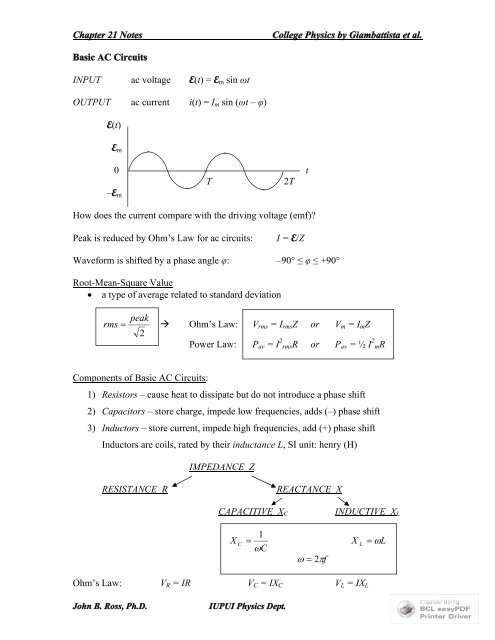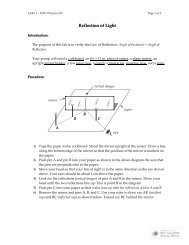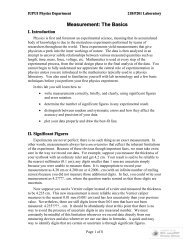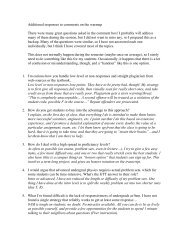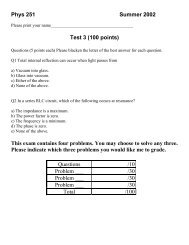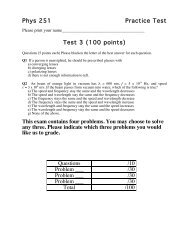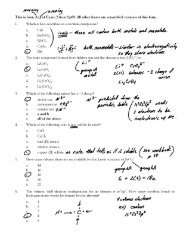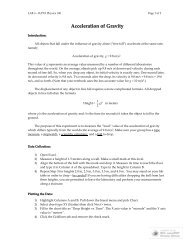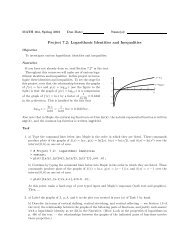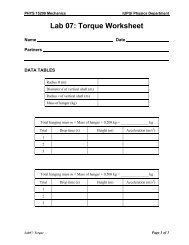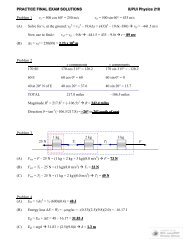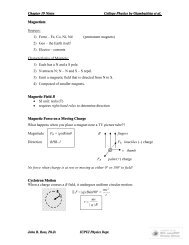Chapter 21 Notes College Physics by Giambattista et al. Basic AC ...
Chapter 21 Notes College Physics by Giambattista et al. Basic AC ...
Chapter 21 Notes College Physics by Giambattista et al. Basic AC ...
Create successful ePaper yourself
Turn your PDF publications into a flip-book with our unique Google optimized e-Paper software.
<strong>Chapter</strong> <strong>21</strong> <strong>Notes</strong><strong>College</strong> <strong>Physics</strong> <strong>by</strong> <strong>Giambattista</strong> <strong>et</strong> <strong>al</strong>.<strong>Basic</strong> <strong>AC</strong> CircuitsINPUT ac voltage E(t) = E m sin ωtOUTPUT ac current i(t) = I m sin (ωt – φ)E(t)E m0 tT 2T–E mHow does the current compare with the driving voltage (emf)?Peak is reduced <strong>by</strong> Ohm’s Law for ac circuits:I = E/ZWaveform is shifted <strong>by</strong> a phase angle φ: –90° ≤ φ ≤ +90°Root-Mean-Square V<strong>al</strong>ue a type of average related to standard deviationpeakrms 2 Ohm’s Law: V rms = I rms Z or V m = I m ZPower Law: P av = I 2 rmsR or P av = ½ I 2 mRComponents of <strong>Basic</strong> <strong>AC</strong> Circuits:1) Resistors – cause heat to dissipate but do not introduce a phase shift2) Capacitors – store charge, impede low frequencies, adds (–) phase shift3) Inductors – store current, impede high frequencies, add (+) phase shiftInductors are coils, rated <strong>by</strong> their inductance L, SI unit: henry (H)IMPEDANCE ZRESISTANCE RRE<strong>AC</strong>TANCE XCAP<strong>AC</strong>ITIVE X CINDUCTIVE X L L1X C C 2fX LOhm’s Law: V R = IR V C = IX C V L = IX LJohn B. Ross, Ph.D.IUPUI <strong>Physics</strong> Dept.
<strong>Chapter</strong> <strong>21</strong> <strong>Notes</strong><strong>College</strong> <strong>Physics</strong> <strong>by</strong> <strong>Giambattista</strong> <strong>et</strong> <strong>al</strong>.Phase Diagram: X L +90°R 0°X C –90°Resonancephenomenon found in a vari<strong>et</strong>y of physic<strong>al</strong> systemsdiscuss pumping legs on swing, cracking glass with sound, music<strong>al</strong> instruments,Tacoma Narrows Bridge in Wash.What happens when the driving frequency equ<strong>al</strong>s ω 0 ?Maximum currentMinimum tot<strong>al</strong> impedanceCurrent in phase with driving voltageMaximum power transferred from source to circuitX L = X C 0 1LCJohn B. Ross, Ph.D.IUPUI <strong>Physics</strong> Dept.


